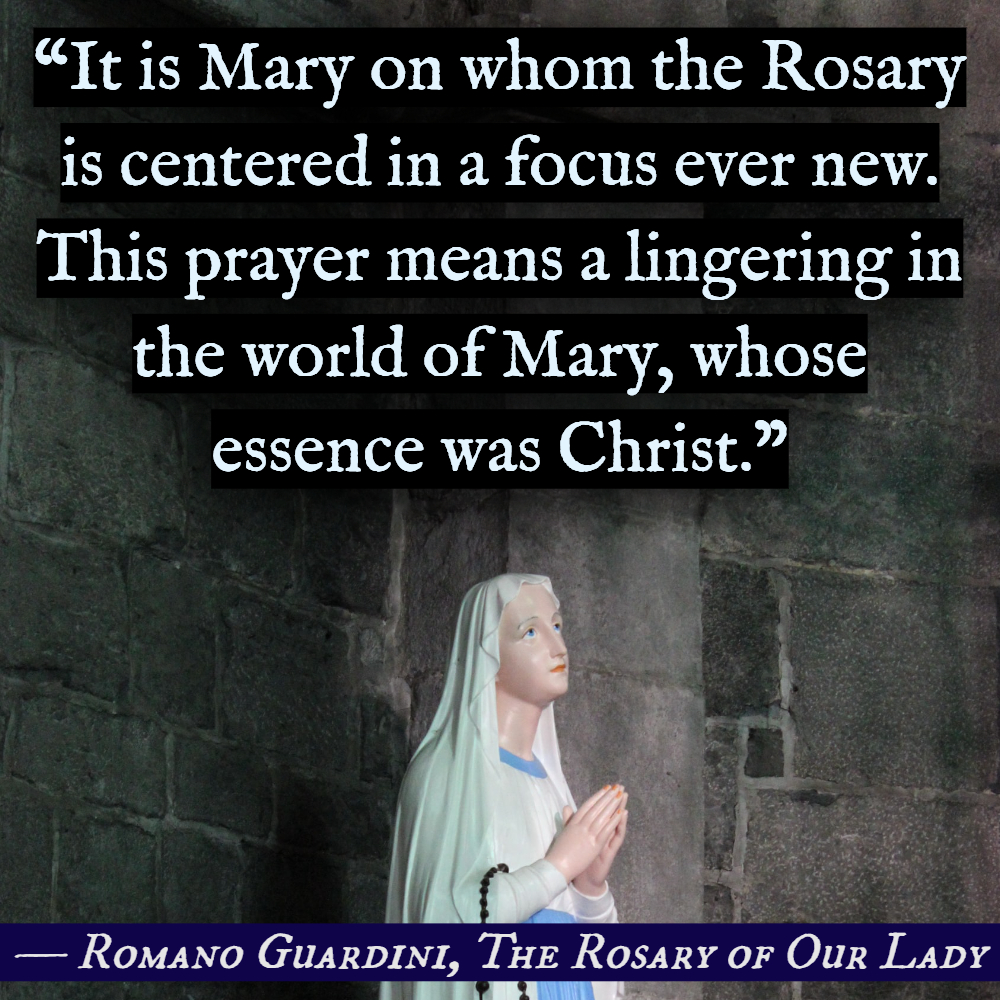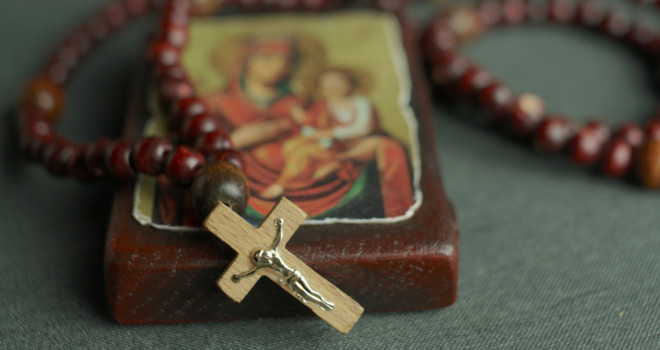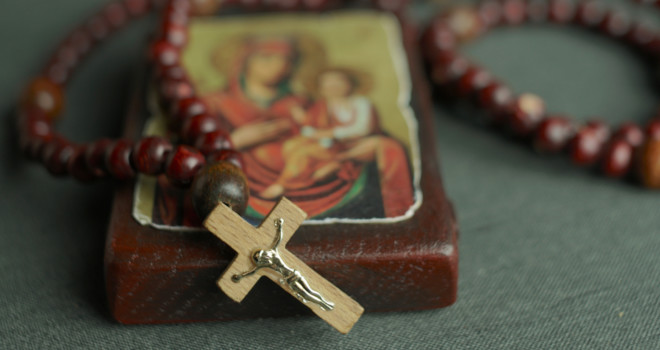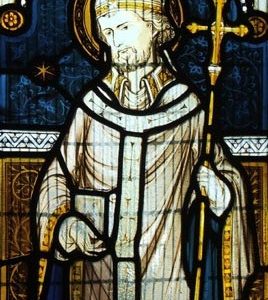The Christian people have always loved Mary with a love especially reserved for her, and it was not a good omen when Christians thought of severing their bond to Mary in order to honor the Son.
Who is Mary? Let us say it as simply as it can possibly be said: she is the woman for whom Jesus Christ, the Son of God and our Redeemer, became the main purpose of life. This fact is as simple and at the same time as far beyond all human understanding as is the mystery of our Lord’s Incarnation.
There are two possibilities of greatness. One is to be great oneself: a creator, a hero, a herald, a man of special destiny. The other is to love such a great person; and this possibility seems of equal value. In order to comprehend the life of someone else, one’s own heart should measure up to the image of the beloved. What do we mean, then, when we say that Jesus Christ was the substance of Mary’s life?
The limits of the incomparable rise up here, because Christ, though our brother, still has the deepest roots of His being on the side of God. And yet the fact remains that Mary was His mother. Wherever the Gospel speaks of her, not only does she appear as the one who bore and reared the Savior Child, but she stands living, knowing, and loving in this holiest of spheres.
The Angel’s Message
The lesson of the angel’s message alone should suffice for every one of the faithful who reads it aright; it is not the announcement that the divine decree was to be consummated in her, but the question of whether she agreed that it be so. This instant was an abyss before which one’s head reels, because here stood Mary in her freedom facing the very first decision on which all of salvation depended. But what does it mean when the question “Will you help the Savior’s coming?” coincides with the other question, “Will you become a mother?”
What does it mean that she received the Son of God and the Savior; that she carried and bore Him? That she feared for His life and wandered into exile for Him? That He grew up beside her in the tranquility of the home in Nazareth, then left her on His mission, while she, as the Gospel hints, followed Him with her love, standing, at the end, beneath the Cross? That she knew of the Resurrection and waited after the Ascension in the midst of the Apostles for the descent of the Holy Spirit whose power overshadowed her? That she continued to live on in the care of the Apostle “who was loved by Jesus” and to whom He Himself entrusted her until her Son and Master called her?

Scripture says little about this, but for those who wish to understand, the texts are eloquent; all the more so because it is Mary’s own voice we hear. For where else should the disciples have learned about the mystery of the Incarnation, about the first happenings of Christ’s childhood, and the pilgrimage to Jerusalem? If we do not want to look upon the first chapters of the Gospels as legends (we have to know what we are doing in this case, for we are daring to decide which of the Gospels’ words are words of God and setting aside Revelation), we can only say that Mary’s recollections, her testimony, her whole life are the foundation of all accounts of Christ’s childhood. And they are not only the foundation; for how could she have lived with the Master for thirty years and not spoken about Him after His departure? No one can gauge the effect of her narrative on the understanding of Christ and the spread of Christian teaching.
The course of this life contains nothing fictitious, nothing legendary. It is quite simple, quite real — but with what reality! Legends often sound pious and profound in meaning, often fanciful, and sometimes even foolish. Even when they are really devout, they can do harm. They tell wonderful tales, but often impair and weaken the meaning of something that is much more beautiful and devout, and much more wonderful than all legends — namely, reality.
The life of Mary, as the Gospel tells it, is as humanly true as it can possibly be, but in this human quality it is filled with a mystery of divine communion and love, the depth of which is unfathomable. The Rosary points in this direction.
The Substance of Mary’s Life
Jesus is the substance of Mary’s life, just as the child is the lifeblood of its mother, for whom it is the one and all. But, at the same time, He is also her Redeemer, and that another child cannot be for its mother. Speaking of another child and mother in such a manner is like “making conversation”: as soon as the speech takes a serious turn, it borders on blasphemy. Not only was Mary’s existence as a human mother achieved in her relation to Jesus, but also her redemption. Becoming a mother, she became a Christian. By living with her Child, she lived with the God whose living revelation He is. Growing humanly along with the Child, as do all mothers who really love, releasing Him on the road of life with so much resignation and pain, she ripened in God’s divine grace and truth.
For this reason, Mary is not only a great Christian, one among a number of saints, but she is unique. No one is like her, because what happened to her happened to no other human being. Here lies the authentic root of all exaggeration about her. If people cannot be extravagant enough in their praises of Mary, and even say reckless and foolish things, they are still right in one respect: even though the means are faulty, they seek to express a fact, the tremendous depth of which must overwhelm everyone who realizes it. But exaggerations are useless and harmful, because the simpler the word expressing a truth, the more tremendous and at the same time the more deeply realized do the facts become.
It is Mary on whom the Rosary is centered in a focus ever new. This prayer means a lingering in the world of Mary, whose essence was Christ.
In this way, the Rosary is, in its deepest sense, a prayer of Christ. The first part of the Hail Mary ends with His name: “And blessed is the fruit of thy womb, Jesus.” After this name follow the so-called mysteries (for example, “Whom thou, O Virgin, didst conceive of the Holy Spirit,” “Whom thou didst bear with thee to Elizabeth,” “Who was born to thee in Bethlehem”). Every decade of the Rosary contains such a mystery.
The whole, as it is expressed in the chain of beads, includes five decades and thus forms a cycle of five mysteries.
We see how, in this prayer, the figure and life of Jesus occupies the foreground: not as He does in the Stations of the Cross, immediate and in itself, but through Mary, as the tenor of His life is seen and sensed by her, “keeping all these things carefully in her heart.”
The essence of the Rosary is a steady incitement to holy sympathy. If a person becomes very important to us, we are happy to meet someone who is attached to him. We see his image mirrored in another life and we see it anew. Our eyes meet two eyes that also love and see. Those eyes add their range of vision to ours, and our gaze may now go beyond the narrowness of our own ego and embrace the beloved being, previously seen only from one side. The joys that the other person experienced, and also the pains he suffered, become so many strings whose vibrations draw from our heart new notes, new understanding, and new responses.
It is intrinsic in the virtue of sympathy that the other person puts his life at our disposal, which enables us to see and to love not only with our own senses but also with his. Something of this sort, only on a higher plane, happens with the Rosary.
✠
This article is from a chapter in Fr. Guardini’s The Rosary of Our Lady. It is available from your favorite bookstore or online through Sophia Institute Press.












